
(Download a higher resolution picture by clicking on any
picture below.) 
Burt Rutan and Scale Composites have been responsible for producing many novel and innovative aircraft.
In June 1974 Burt Rutan left his job at Bede Test Center, moved his family to Mojave, California, and started Rutan Aircraft Factory (RAF) in order to develop a non-conventional research aircraft he had designed while still in college, the VariViggen.
Link to the Rutan Aircraft Factory web site.
Burt Rutan transformed the whole approach to the traditional design and construction of homebuilt aircraft when he began selling plans to build the VariEze ('very easy') during the summer of 1976. Propelled by a 100-horsepower engine, a VariEze could carry two adults for about 700 miles at approximately 180 mph.
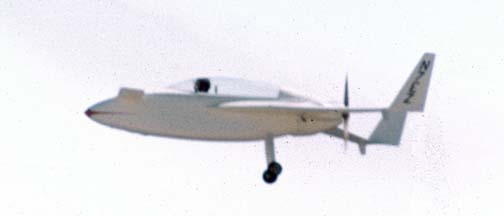 Prototype Vari-Eze, N7EZ at the Mojave Airport on June 18, 1975. N7EZ has
been registered to the Experimental Aircraft Association Aviation Foundation
Incorporated of Oshkosh, Wisconson since August 3, 1983.
Prototype Vari-Eze, N7EZ at the Mojave Airport on June 18, 1975. N7EZ has
been registered to the Experimental Aircraft Association Aviation Foundation
Incorporated of Oshkosh, Wisconson since August 3, 1983.
Link to the National Air & Space Museum's page about the VariEze.
The AD-1 Oblique Wing Demonstrator is a research aircraft to test the "skew-wing" system of variable geometry. The Rutan Aircraft Factory provided the detailed design and load analysis for the intentionally low-speed, low-cost airplane. It was powered by Two Microturbo TRS-18 turbojet engines, each producing 220 pounds of static thrust at sea level.
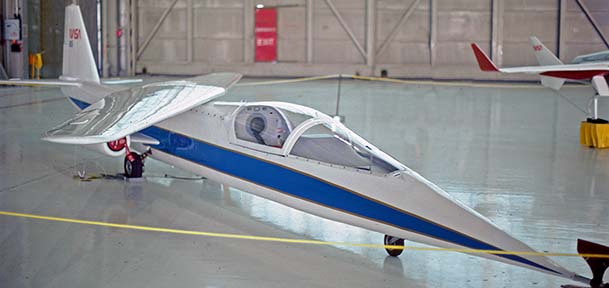 AD-1 Oblique Wing Demonstrator, N805NA at the Edwards
Air Force Base open house on September 20, 1981.
AD-1 Oblique Wing Demonstrator, N805NA at the Edwards
Air Force Base open house on September 20, 1981.
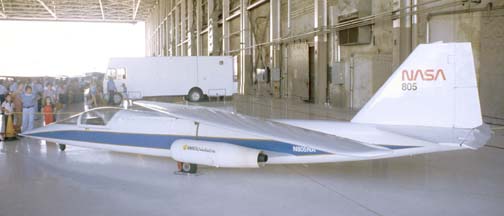 AD-1 Oblique Wing Demonstrator, N805NA at the Edwards
Air Force Base open house on September 20, 1981.
AD-1 Oblique Wing Demonstrator, N805NA at the Edwards
Air Force Base open house on September 20, 1981.
Link to the NASA Dryden Flight Reserch Center Fact Sheet for the AD-1 Oblique Wing demonstrator.
In April 1982, Burt Rutan founded Scaled Composites, Inc. to develop research aircraft. The company currently employs 130 people at the Mojave, California airport.
Link to the Scaled Composites, Incorporated web site
The Voyager aircraft was designed and fabricated for a single mission: Fly around the world non-stop non-refueled.
Link to the National Air & Space Museum's page about the Voyager.
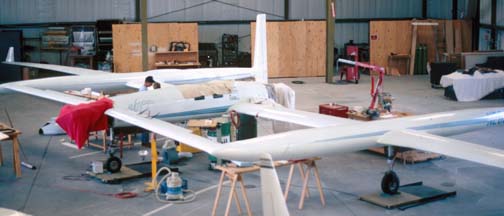 The nearly complete Voyager, N269VA at the Mojave Airport on
August 9, 1986. It made the first non-stop round the world flight from
Edwards Air Force Base over the period from December 14 to December 23, 1986.
The nearly complete Voyager, N269VA at the Mojave Airport on
August 9, 1986. It made the first non-stop round the world flight from
Edwards Air Force Base over the period from December 14 to December 23, 1986.
 The nearly complete Voyager, N269VA at the Mojave Airport on
August 9, 1986.
The nearly complete Voyager, N269VA at the Mojave Airport on
August 9, 1986.
 3-D view of the nearly complete Voyager, N269VA at the Mojave Airport on
August 9, 1986. Cross your eyes until the two images line up to see
the Voyager in 3-D.
3-D view of the nearly complete Voyager, N269VA at the Mojave Airport on
August 9, 1986. Cross your eyes until the two images line up to see
the Voyager in 3-D.
In 1979, Beech decided to begin work on a new pressurized, all-composite twin-engine business turboprop, a brand new generation of aircraft based on latest building materials technology and a bold new, innovative design, that would become the Beechcraft Starship. In 1982, Beech approached Rutan and his company, Scaled Composites in Mojave, California, to participate in the final configuration study. Scaled Composites was engaged to build an 85 percent scale proof of-concept prototype to flight-test the configuration.
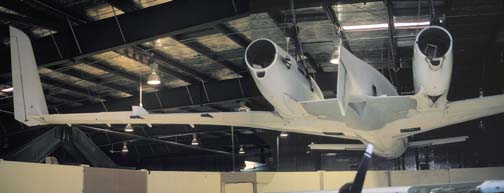 Starship 85%-scale prototype, N2000P suspended in the
Scaled Composites hangar at the Mojave Airport on
November 9, 1986.
Starship 85%-scale prototype, N2000P suspended in the
Scaled Composites hangar at the Mojave Airport on
November 9, 1986.
Link to Bob Schearer's Starship Development and Construction Page.
The Grizzly is a tandem-wing, STOL research aircraft powered by a 180-horsepower Avco Lycoming IO-360-B.
 Rutan Model 72 Grizzly N80RA taxiing at the Mojave Airport on
November 9, 1986.
Rutan Model 72 Grizzly N80RA taxiing at the Mojave Airport on
November 9, 1986.
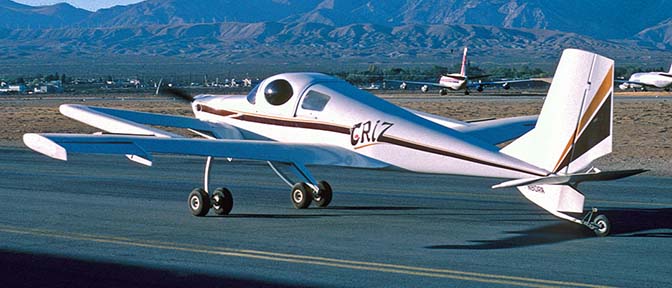 Rutan Model 72 Grizzly N80RA taxiing at the Mojave Airport on
November 9, 1986.
Rutan Model 72 Grizzly N80RA taxiing at the Mojave Airport on
November 9, 1986.
The Grizzly is now in the collection of the Experimental Aircraft Association Air Venture Museum in Oshkosh, Wisconson.
The Model 133-4.62 Advanced Technology Tactical Transport (ATTT) proof-of-concept demonstrator is a 62% scaled version of an airplane designed to challenging STOL and long range requirements. The ATTT was developed and test flown by Scaled Composites, Inc. under contract to DARPA.
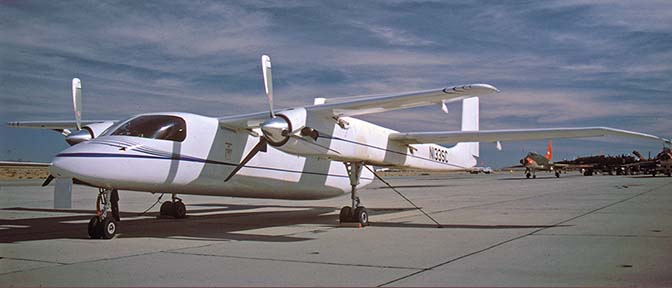 Scaled Composites Model 133-4.62 Advanced Technology
Tactical Transport (ATTT) demonstrator, N133SC on the Mojave Airport
flightline on October 30, 1989. It was built in 1988
as a 68%-scale proof of concept vehicle.
Scaled Composites Model 133-4.62 Advanced Technology
Tactical Transport (ATTT) demonstrator, N133SC on the Mojave Airport
flightline on October 30, 1989. It was built in 1988
as a 68%-scale proof of concept vehicle.
 Scaled Composites Model 133-4.62 Advanced Technology
Tactical Transport (ATTT) demonstrator, N133SC on the Mojave Airport
flightline on October 30, 1989.
Scaled Composites Model 133-4.62 Advanced Technology
Tactical Transport (ATTT) demonstrator, N133SC on the Mojave Airport
flightline on October 30, 1989.
 Scaled Composites Model 133-4.62 Advanced Technology
Tactical Transport (ATTT) demonstrator, N133SC on the Edwards Air
Force Base south base flightline on October 25, 2003.
Scaled Composites Model 133-4.62 Advanced Technology
Tactical Transport (ATTT) demonstrator, N133SC on the Edwards Air
Force Base south base flightline on October 25, 2003.
The Beechcraft Starship 2000 is the world's first pressurized, all-composite business turboprop.
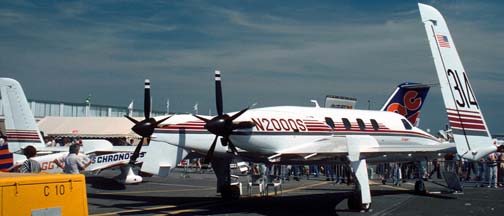 Starship, N2000S at the Paris Airshow on June 18, 1989. It
was sold to a French client and registered F-WZCJ.
Starship, N2000S at the Paris Airshow on June 18, 1989. It
was sold to a French client and registered F-WZCJ.
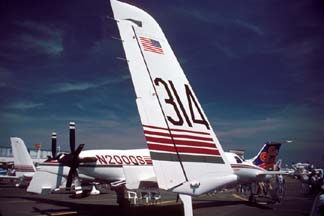 Starship, N2000S at the Paris Airshow on June 18, 1989. It
was sold to a French client and registered F-WZCJ.
Starship, N2000S at the Paris Airshow on June 18, 1989. It
was sold to a French client and registered F-WZCJ.
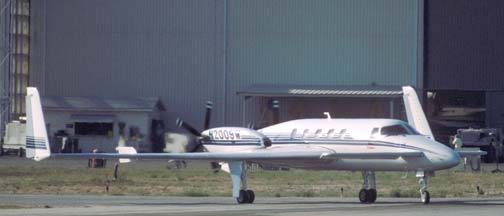 Starship, N2009W at the Santa Barbara Airport on
July 19, 1990.
Starship, N2009W at the Santa Barbara Airport on
July 19, 1990.
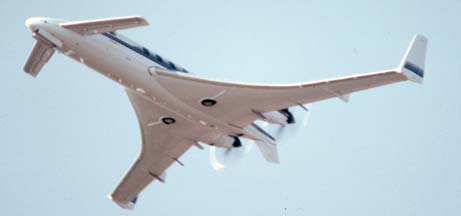 Starship, N2009W flying over the Santa Barbara Airport on
July 19, 1990.
Starship, N2009W flying over the Santa Barbara Airport on
July 19, 1990.
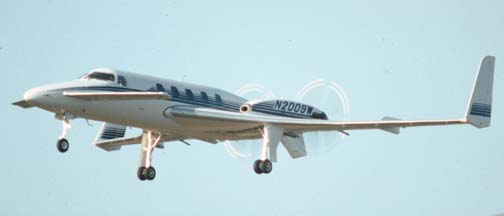 Starship, N2009W landing at the Santa Barbara Airport on
July 19, 1990.
Starship, N2009W landing at the Santa Barbara Airport on
July 19, 1990.
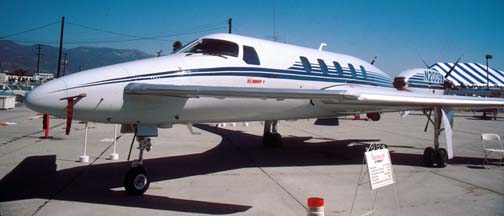 Starship, N2009W at the Santa Barbara Airport on
October 20, 1990.
Starship, N2009W at the Santa Barbara Airport on
October 20, 1990.
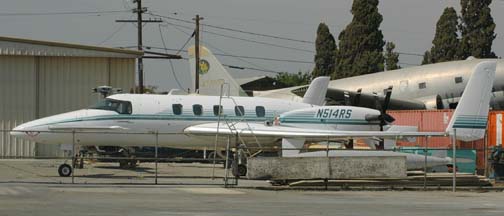 Bob Scherer's Starship NC-51, N514RS at the Chino Airport on
May 16, 2004. It flies chase on mission of the White Knight and SpaceShipOne.
It is one of about nine starships that remain in operation.
Most of the rest have been parked at Pinal Airpark near Marana, Arizona.
Bob Scherer's Starship NC-51, N514RS at the Chino Airport on
May 16, 2004. It flies chase on mission of the White Knight and SpaceShipOne.
It is one of about nine starships that remain in operation.
Most of the rest have been parked at Pinal Airpark near Marana, Arizona.
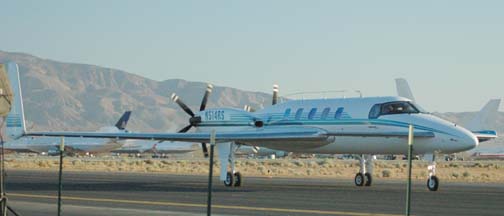 Bob Scherer's Beechcraft Starship NC-51, N514RS served as "high chase"
on missions of the White Knight and SpaceShipOne. It is one of about nine starships that remain in operation.
Most of the rest have been parked at Pinal Airpark near Marana, Arizona.
Bob Scherer's Beechcraft Starship NC-51, N514RS served as "high chase"
on missions of the White Knight and SpaceShipOne. It is one of about nine starships that remain in operation.
Most of the rest have been parked at Pinal Airpark near Marana, Arizona.
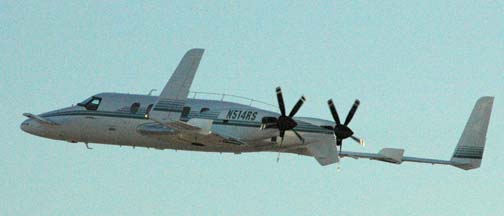 Beechcraft Starship, N514RS at Mojave on June 21, 2004.
Beechcraft Starship, N514RS at Mojave on June 21, 2004.
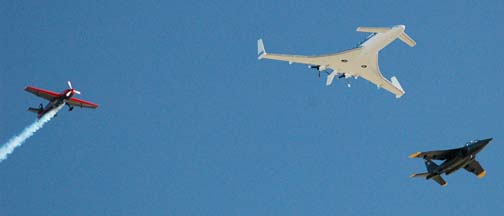 Beechcraft Starship, N514RS, the Alphajet, and Extra 300, N12DW fly
over the Mojave Airport before breaking into the landing pattern.
Beechcraft Starship, N514RS, the Alphajet, and Extra 300, N12DW fly
over the Mojave Airport before breaking into the landing pattern.
 Bob Scheerer's Beechcraft Starship, N514RS at Mojave on October 4, 2004.
Bob Scheerer's Beechcraft Starship, N514RS at Mojave on October 4, 2004.
 Beechcraft Starship, N514RS escorts White Knight and SpaceShipOne
as they climb to launch altitude
Beechcraft Starship, N514RS escorts White Knight and SpaceShipOne
as they climb to launch altitude
 Beechcraft Starship, N514RS, the Alphajet, and Extra 300, N12DW fly
over the Mojave Airport at 8:15 A.M. before breaking into the landing pattern.
Beechcraft Starship, N514RS, the Alphajet, and Extra 300, N12DW fly
over the Mojave Airport at 8:15 A.M. before breaking into the landing pattern.
Link to Aviator Service's Starship History Article by Max Blech of Beech Aircraft Corporation.
Link to the Starship Diaries web site.
The Quickie was developed in 1978 by T. Jewett, G. Sheehnan and B. Rutan, as a cheap aeroplane to build, and an easy airplane to fly. The airplane has a canard type design, constructed with glass fibre over a foam core.
Link to the National Air & Space Museum's page about the Quickie.
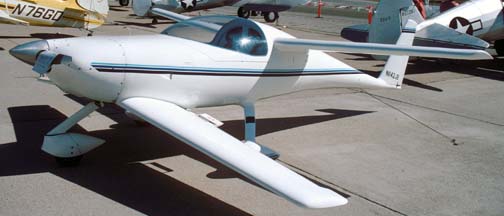 Quickie, N142AB at the Santa Barbara Airport on
October 20, 1990.
Quickie, N142AB at the Santa Barbara Airport on
October 20, 1990.
The all-composite Triumph, an 8500-lb, 41,000-ft capable, pressurized 8-seat corporate aircraft, was designed around the then-unflown Williams FJ-44 turbofan engine. In 1988, Scaled performed the first flight of the Triumph, which was also the first flight tests of the FJ-44.
 Scaled Composites' Triumph all-composite, 8-passenger business jet graced the lawn in front of their hangar on March 23, 2003. It is now on display at the Joe Davies Heritage Air Park in Palmdale.
Scaled Composites' Triumph all-composite, 8-passenger business jet graced the lawn in front of their hangar on March 23, 2003. It is now on display at the Joe Davies Heritage Air Park in Palmdale.
The ARES (Acronym for "Agile Responsive Effective Support") Scaled Model 151, was designed initially in response to a U.S. Army request for a Low Cost Battlefield Attack Aircraft (LCBAA). It is powered by a single Pratt and Whitney Canada JT15D-5 turbofan engine (same as in the Beechjet / T-1A Jayhawk) and is armed with a GAU-12/U 25mm gatling gun. Ares appeared in the movie Aces, Iron Eagle III in the guise of a Messerschmitt 263.
 Ares, N151SC on approach to the Pt. Mugu Naval Weapons Center on
October 12, 1990.
Ares, N151SC on approach to the Pt. Mugu Naval Weapons Center on
October 12, 1990.
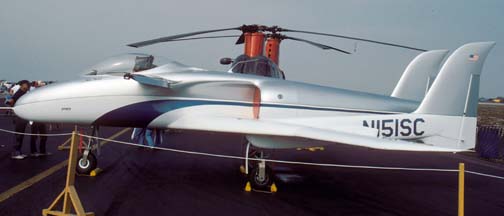 Ares, N151SC on display at the Pt. Mugu Naval Weapons Center airshow on
October 13, 1990. It featured an asymmetric design with the engine inlet on the left side of
the fuselage and a gatling gun on the right side.
Ares, N151SC on display at the Pt. Mugu Naval Weapons Center airshow on
October 13, 1990. It featured an asymmetric design with the engine inlet on the left side of
the fuselage and a gatling gun on the right side.
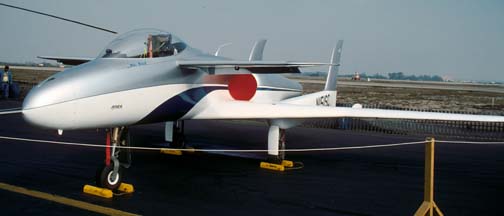 Ares, N151SC on display at the Pt. Mugu Naval Weapons Center airshow on
October 13, 1990.
Ares, N151SC on display at the Pt. Mugu Naval Weapons Center airshow on
October 13, 1990.
 Ares, N151SC on display at the Pt. Mugu Naval Weapons Center airshow on
October 13, 1990.
Ares, N151SC on display at the Pt. Mugu Naval Weapons Center airshow on
October 13, 1990.
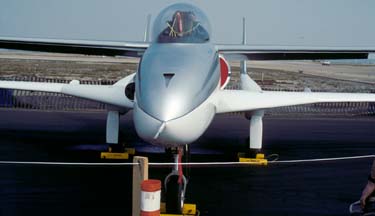 Ares, N151SC on display at the Pt. Mugu Naval Weapons Center airshow on
October 13, 1990. The front view reveals the asymmetric placement of the
engine inlet and gatling gun.
Ares, N151SC on display at the Pt. Mugu Naval Weapons Center airshow on
October 13, 1990. The front view reveals the asymmetric placement of the
engine inlet and gatling gun.
 Ares, N151SC takes off at the Pt. Mugu Naval Weapons Center airshow on
October 13, 1990.
Ares, N151SC takes off at the Pt. Mugu Naval Weapons Center airshow on
October 13, 1990.
Orbital Sciences Corporation developed the Pegasus launch vehicle to provide their customers the lowest cost per pound to place a 1,000 LB payload into low Earth orbit. The Pegasus launch vehicle consists of three solid rocket motor stages with a wing and fins for lift and attitude control of the first stage and gimbaled rocket nozzles on the second and third stages.
Scaled Composites engineering personnel carefully examined the launch profile and developed a composite structure that would meet the OSC performance goals in a cost-effective manner. Scaled Composites is also responsible for the fabrication and test of the Pegasus tail fins.
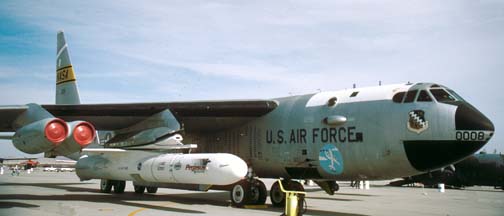 The NB-52B
became the world's first manned, winged, return to launch site
satellite launcher when it launched the Orbital Sciences' Pegasus
booster on April 5, 1990. The NB-52B was displayed with
Pegasus s/n 002 at the October 6, 1990 Edwards Air Force Base
Open House. Pegasus s/n 002 was launched with seven 48-pound
Microsats on July 17, 1991. A failure during the first stage
separation resulted in the satellites failing to achive the
proper orbits. The last Pegasus launch from the
NB-52B took place on August 3, 1994.
The NB-52B
became the world's first manned, winged, return to launch site
satellite launcher when it launched the Orbital Sciences' Pegasus
booster on April 5, 1990. The NB-52B was displayed with
Pegasus s/n 002 at the October 6, 1990 Edwards Air Force Base
Open House. Pegasus s/n 002 was launched with seven 48-pound
Microsats on July 17, 1991. A failure during the first stage
separation resulted in the satellites failing to achive the
proper orbits. The last Pegasus launch from the
NB-52B took place on August 3, 1994.
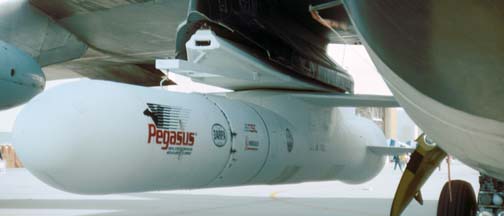 Pegasus s/n 002 at the October 6, 1990 Edwards Air Force Base
Open House.
Pegasus s/n 002 at the October 6, 1990 Edwards Air Force Base
Open House.
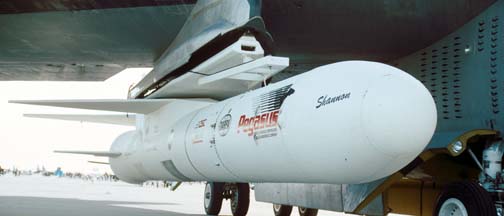 Pegasus s/n 002 at the October 6, 1990 Edwards Air Force Base
Open House. It carried the name Shannon on its nose.
Pegasus s/n 002 at the October 6, 1990 Edwards Air Force Base
Open House. It carried the name Shannon on its nose.
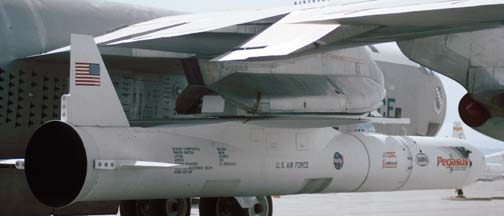 Pegasus s/n 002 at the October 6, 1990 Edwards Air Force Base
Open House.
Pegasus s/n 002 at the October 6, 1990 Edwards Air Force Base
Open House.
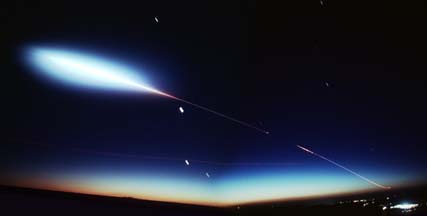 A Pegasus-XL rocket was launched from Stargazer,
the Orbital Sciences L-1011, at 6:56 P.M. on March 4, 1999. Its
payload was the Wide-field Infra Red Explorer (WIRE) satellite.
The booster climbed out of the earth's shadow during the second
stage engine burn in this time exposure. It is framed by the
planets Mercury, Jupiter, Venus, and Saturn. The bright spot at
the lower right is the lights of the town of Buellton in the
Santa Ynez Valley.
A Pegasus-XL rocket was launched from Stargazer,
the Orbital Sciences L-1011, at 6:56 P.M. on March 4, 1999. Its
payload was the Wide-field Infra Red Explorer (WIRE) satellite.
The booster climbed out of the earth's shadow during the second
stage engine burn in this time exposure. It is framed by the
planets Mercury, Jupiter, Venus, and Saturn. The bright spot at
the lower right is the lights of the town of Buellton in the
Santa Ynez Valley.
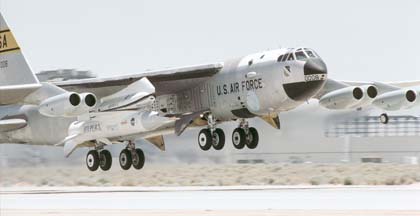 The first X-43A, Hyper-X was launched from
NASA's NB-52B, 52-0008 on June 2, 2001. The X-43A was boosted by
a modified version of the Pegasus.
The first X-43A, Hyper-X was launched from
NASA's NB-52B, 52-0008 on June 2, 2001. The X-43A was boosted by
a modified version of the Pegasus.
 The first X-43A, Hyper-X was launched from
NASA's NB-52B, 52-0008 on June 2, 2001.
The first X-43A, Hyper-X was launched from
NASA's NB-52B, 52-0008 on June 2, 2001.
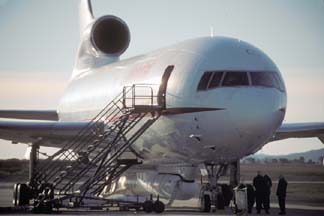 A Pegasus XL booster with the
High Energy Solar Spectroscopic Imager (HESSI) satellite was transported from
Vandenberg Air Force Base to the Kennedy Space Center by
Orbital Sciences Corporation L-1011, N140SC Stargazer on February 1, 2002.
The 3-stage Pegasus XL booster with the HESSI satellite is
visible underneath the fuselage of the Lockheed Tri-Star at Vandenberg Air Force
Base on February 1, 2002.
A Pegasus XL booster with the
High Energy Solar Spectroscopic Imager (HESSI) satellite was transported from
Vandenberg Air Force Base to the Kennedy Space Center by
Orbital Sciences Corporation L-1011, N140SC Stargazer on February 1, 2002.
The 3-stage Pegasus XL booster with the HESSI satellite is
visible underneath the fuselage of the Lockheed Tri-Star at Vandenberg Air Force
Base on February 1, 2002.
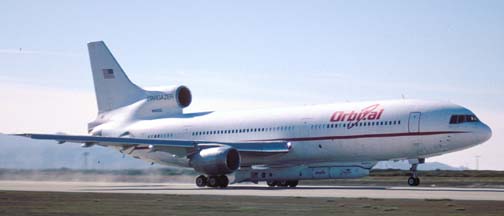 Orbital Sciences Corporation L-1011, N140SC Stargazer takes off
from Vandenberg Air Force Base with the HESSI spacecraft, February 1, 2002.
The HESSI mission was successfully launched off the coast of Florida at 12:58 P.M.
EST on Tuesday, February 5.
Orbital Sciences Corporation L-1011, N140SC Stargazer takes off
from Vandenberg Air Force Base with the HESSI spacecraft, February 1, 2002.
The HESSI mission was successfully launched off the coast of Florida at 12:58 P.M.
EST on Tuesday, February 5.
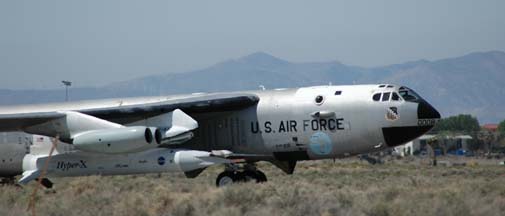 The second X-43A, Hyper-X was launched from
NASA's NB-52B, 52-0008 on March 27, 2004. The Supersonic Combustion Ramjet operated successfully at Mach 7.
The second X-43A, Hyper-X was launched from
NASA's NB-52B, 52-0008 on March 27, 2004. The Supersonic Combustion Ramjet operated successfully at Mach 7.
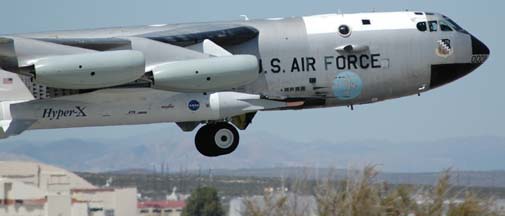 NASA
008, Boeing NB-52B Stratofortress, 52-0008 lifts off. The Pegasus
booster was modified by the removal of 3,300 pounds of excess
propellant. The propellant was machined out, removing the star
shaped fins commonly found in solid fuel rockets. In order to
compensate for weight and center of gravity changes, its rocket engine
bell was built of steel instead of aluminum to increase its weight.
NASA
008, Boeing NB-52B Stratofortress, 52-0008 lifts off. The Pegasus
booster was modified by the removal of 3,300 pounds of excess
propellant. The propellant was machined out, removing the star
shaped fins commonly found in solid fuel rockets. In order to
compensate for weight and center of gravity changes, its rocket engine
bell was built of steel instead of aluminum to increase its weight.
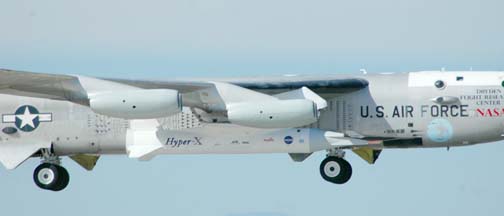 The third X-43A, Hyper-X was launched from
NASA's NB-52B, 52-0008 on November 16, 2004. The Supersonic Combustion Ramjet operated successfully at Mach 9.6.
The third X-43A, Hyper-X was launched from
NASA's NB-52B, 52-0008 on November 16, 2004. The Supersonic Combustion Ramjet operated successfully at Mach 9.6.
Scaled Composites Model 281 Proteus is a twin turbofan high altitude. multi-mission aircraft powered by Williams International FJ44-2E engines. It is designed to carry payloads in the 2000-pound class to altitudes above 60,000 feet and remain on station up to 14 hours.
 Proteus N281PR at the Edwards Air Force Base
open house on October 9, 1999. At the time, it was registered to Angel Technologies Corporation of St. Louis,
Missouri. It has been registered to Northrop-Grumman Corporation since March 7, 2002.
It is configured for telecommunications relay.
Proteus N281PR at the Edwards Air Force Base
open house on October 9, 1999. At the time, it was registered to Angel Technologies Corporation of St. Louis,
Missouri. It has been registered to Northrop-Grumman Corporation since March 7, 2002.
It is configured for telecommunications relay.
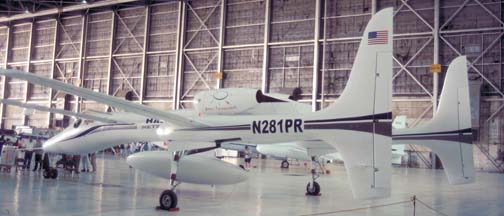 Proteus, N281PR at the Edwards Air Force Base
open house on October 9, 1999.
Proteus, N281PR at the Edwards Air Force Base
open house on October 9, 1999.
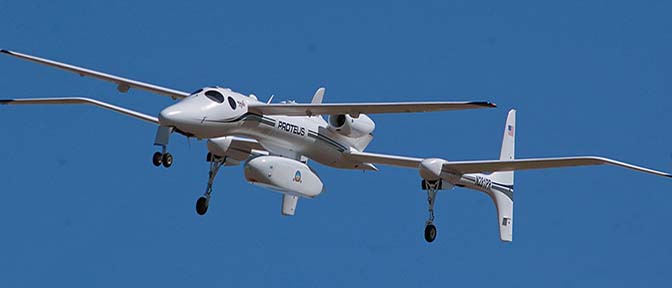 Proteus on approach to the Mojave Airport on March 15, 2005.
Proteus on approach to the Mojave Airport on March 15, 2005.
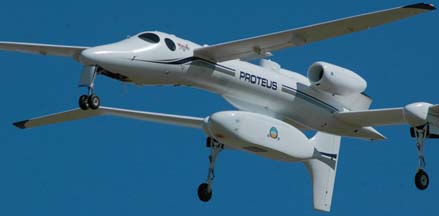 Proteus had been flying out of Knoxville, Tennessee for a week.
Proteus had been flying out of Knoxville, Tennessee for a week.
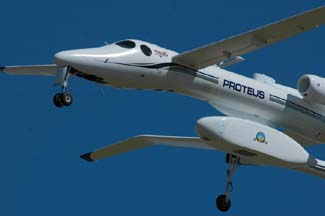 It is carrying a large pod with a window on the underside.
It is carrying a large pod with a window on the underside.
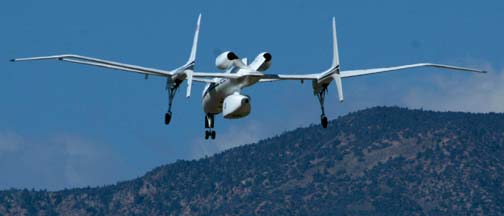 Proteus is also simulating a high-altitude, precision-strike UAV in tests conducted at Nellis Air Foce Base.
Proteus is also simulating a high-altitude, precision-strike UAV in tests conducted at Nellis Air Foce Base.
 Proteus returned to the Mojave Airport from a four-day visit to McGhee-Tyson Airport at Knoxville, Tennessee on December 10, 2005.
Proteus returned to the Mojave Airport from a four-day visit to McGhee-Tyson Airport at Knoxville, Tennessee on December 10, 2005.
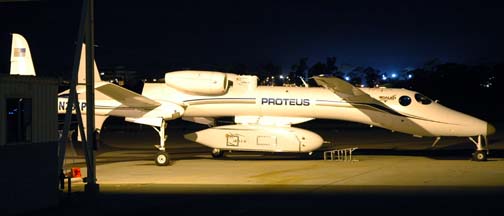 Proteus, N281PR stayed overnight at the Santa Barbara Airport on January 11, 2006.
Proteus, N281PR stayed overnight at the Santa Barbara Airport on January 11, 2006.
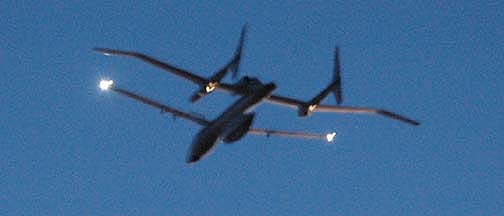 It departed at 6:40 A.M. on January 12, about 25 minutes before sunrise. It flew to Kwajalein Atoll by way of Honolulu.
It departed at 6:40 A.M. on January 12, about 25 minutes before sunrise. It flew to Kwajalein Atoll by way of Honolulu.
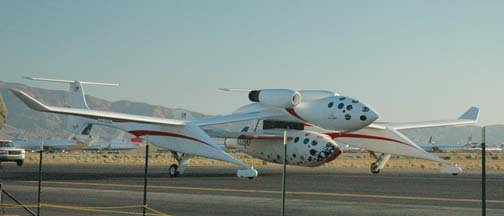 Scaled Composites' SpaceShipOne
made the first
privately funded manned flight to 100 Kilometers altitude from the Mojave Airport
early in the morning on
Monday, June 21, 2004. Pilot Mike Melvill earned his astronaut's wings and
experienced three minutes of weightlessness during the flight into space.
Scaled Composites' SpaceShipOne
made the first
privately funded manned flight to 100 Kilometers altitude from the Mojave Airport
early in the morning on
Monday, June 21, 2004. Pilot Mike Melvill earned his astronaut's wings and
experienced three minutes of weightlessness during the flight into space.
The flight was part of the envelope expansion phase of an attempt to win the
$10,000,000 Ansari X-Prize
Send a message to Brian. Go to home page of the Goleta Air and
Space Museum.  Burt Rutan's SpaceShipOne won the Ansari X-Prize on October 4, 2004 for making two flights to
an altitude of 100 kilometers from the Mojave Airport within
two weeks.
Burt Rutan's SpaceShipOne won the Ansari X-Prize on October 4, 2004 for making two flights to
an altitude of 100 kilometers from the Mojave Airport within
two weeks. 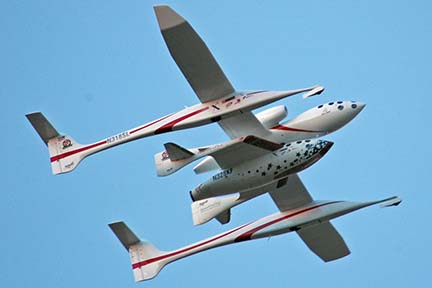 White Knight and Burt Rutan's SpaceShipOne
White Knight and Burt Rutan's SpaceShipOne
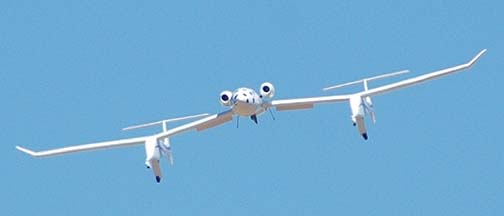 Rutan's White Knight, N318SL returned to the Mojave Airport from display at the Experimental Aircraft Association Fly-in at Oshkosh, Wisconson on August 2, 2005. It left SpaceShipOne at Dulles International Airport to be put on display in the Milestones of Flight Gallery at the National Air & Space Museum. On its journey it visited Albuquerque, Tulsa, Dane County Regional-Truax Field at Madison, Wisconson, Wright Patterson Air Force Base, Dulles International, Spirit of St. Louis Airport at St. Louis, Missouri, and Pueblo, Colorado.
Rutan's White Knight, N318SL returned to the Mojave Airport from display at the Experimental Aircraft Association Fly-in at Oshkosh, Wisconson on August 2, 2005. It left SpaceShipOne at Dulles International Airport to be put on display in the Milestones of Flight Gallery at the National Air & Space Museum. On its journey it visited Albuquerque, Tulsa, Dane County Regional-Truax Field at Madison, Wisconson, Wright Patterson Air Force Base, Dulles International, Spirit of St. Louis Airport at St. Louis, Missouri, and Pueblo, Colorado.